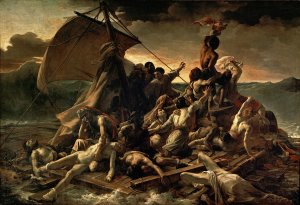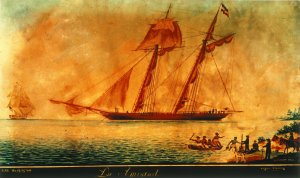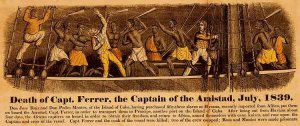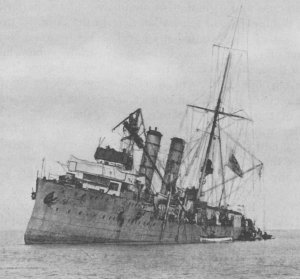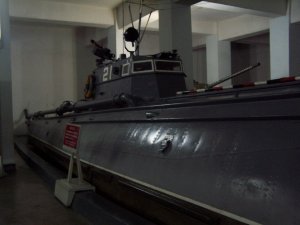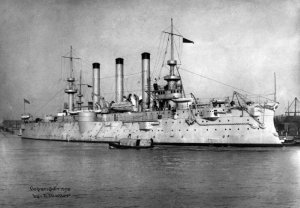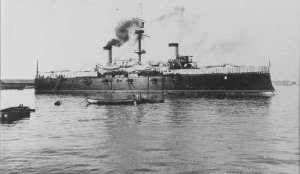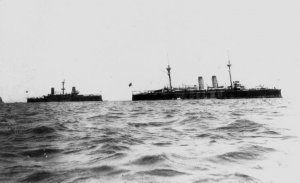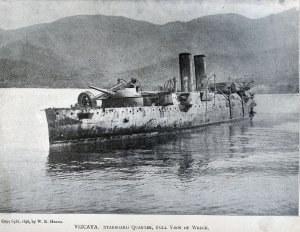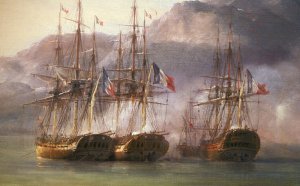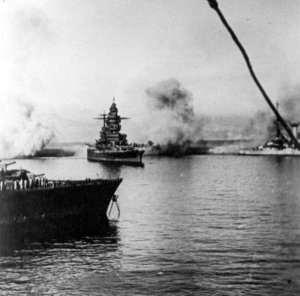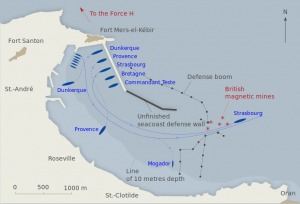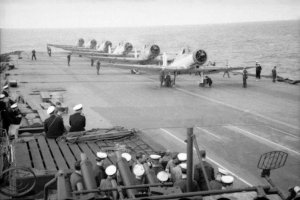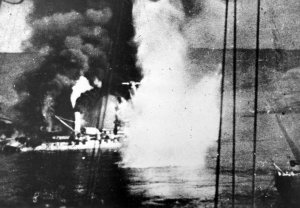1 July 1942 -
Montevideo Maru
was a Japanese auxiliary ship that was
sunk in World War II, resulting in the drowning of a large number of Australian prisoners of war and civilians being transported from
Rabaul. Prior to the war, it operated as a passenger and cargo vessel, traveling mainly between Asia and South America.
Ship history
Montevideo Maru was one of three ships (along with
Santos Maru and
La Plata Maru) of the
Osaka Shosen Kaisha (OSK) shipping line built for their trans-Pacific service to South America. The 7,267 ton ship was constructed at the
Mitsubishi Zosen Kakoki Kaisha shipyard at
Nagasaki, and launched in 1926. At 430
feet (130
metres) in length, and 56 ft (17 m) in the beam, she was powered by two Mitsubishi-
Sulzer 6ST60 six-cylinder
diesel engines delivering a total of 4,600
horsepower (3,400
kilowatts) and giving her a speed of 14.5
knots (26.9
kilometres per hour; 16.7
miles per hour).
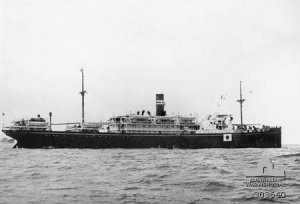 Sinking
Sinking
On 22 June 1942, some weeks after the
fall of Rabaul to the
Japanese, a large number of
Australian prisoners were embarked from Rabaul's port on
Montevideo Maru. Unmarked as a
POW ship, she was proceeding without escort to the Chinese island of
Hainan, when she was sighted by the American
submarine Sturgeon near the northern
Philippine coast on 30 June.
Sturgeon pursued, but was unable to fire, as the target was traveling at 17 kn (31 km/h; 20 mph). However, it slowed to about 12 kn (22 km/h; 14 mph) at midnight; according to crewman Yoshiaki Yamaji, it was to rendezvous with an escort of two
destroyers. Unaware that it was carrying Allied prisoners of war and civilians,
Sturgeon fired four
torpedoes at
Montevideo Maru before dawn of 1 July, causing the vessel to sink in only 11 minutes. According to Yamaji, Australians in the water sang "
Auld Lang Syne" to their trapped mates as the ship sank beneath the waves.
Should Old Acquaintance be forgot,
and never thought upon;
The flames of Love extinguished,
and fully past and gone:
Is thy sweet Heart now grown so cold,
that loving Breast of thine;
That thou canst never once reflect
On old long syne.
CHORUS:
On old long syne my Jo,
On old long syne,
That thou canst never once reflect,
On old long syne.
There were more POWs in the water than crew members. The POWs were holding pieces of wood and using bigger pieces as rafts. They were in groups of 20 to 30 people, probably 100 people in all. They were singing songs. I was particularly impressed when they began singing Auld Lang Syne as a tribute to their dead colleagues. Watching that, I learnt that Australians have big hearts.
— Eyewitness Yoshiaki Yamaji, interviewed Oct. 2003
The sinking is considered the worst maritime disaster in Australia's history. A nominal list made available by the Japanese government in 2012 revealed that a total of 1054 prisoners (178 non-commissioned officers, 667 soldiers and 209 civilians) died on the
Montevideo Maru. Of the ship's total complement, approximately twenty Japanese crew survived, out of an original 88 guards and crew.
Among the missing prisoners was Reverend Syd Beazley of the Methodist Mission, the uncle of former
Australian Labor Party opposition leader
Kim Beazley. Another was Tom Vernon Garrett, the grandfather of
Midnight Oil lead singer and former Australian
Minister for School Education, Early Childhood and Youth,
Peter Garrett. Another individual, Richard Kingsmill Pennefather Moore, had served in the
Imperial Camel Corps as a lieutenant and was awarded a
Military Cross. His son, William Richard Moore, married Nora Wish Garrett, aunt of
Peter Garrett. Also lost were 22
Salvation Army bandsmen, the majority being members of the Brunswick Citadel band. The bandsmen had enlisted together and comprised the majority of the band of the 2/22nd Battalion.
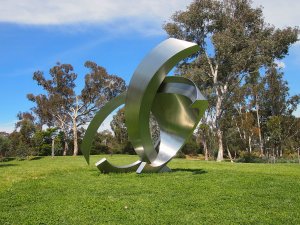
The memorial to the Australians killed in the defence of Rabaul and the sinking of the MV
Montevideo Maru on the eastern side of the Australian War Memorial in November 2012
Memorials
A memorial to those who lost their lives was erected at the Repatriation Hospital, Bell Street,
Heidelberg,
Melbourne,
Victoria (Australia). A
Montevideo Maru memorial has also been erected near the centre of the
Australian Ex-Prisoners of War Memorial in
Ballarat, Victoria. A commemoration service was held at the unveiling of the memorial on 7 February 2004.
In late January 2010, Federal
Member of Parliament,
Stuart Robert, called upon the then
Prime Minister of Australia,
Kevin Rudd, to back the search for
Montevideo Maru, in the same way that he had supported the search for
AHS Centaur.
The song "In the Valley" from the album
Earth and Sun and Moon by Australian pop/rock band
Midnight Oil opens with the autobiographical line, "My grandfather went down with the
Montevideo/The Rising Sun sent him floating to his rest," sung by
Peter Garrett.
https://en.wikipedia.org/wiki/SS_Montevideo_Maru
https://en.wikipedia.org/wiki/Auld_Lang_Syne
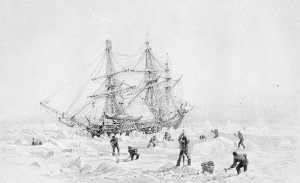





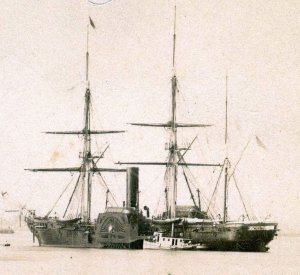
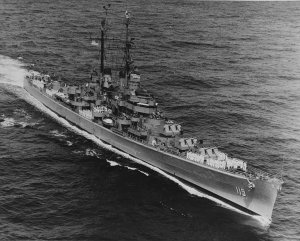
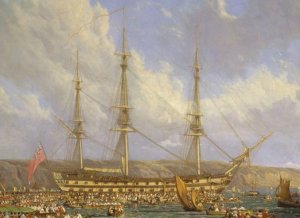

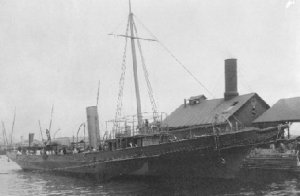
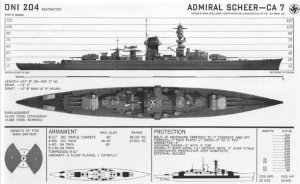
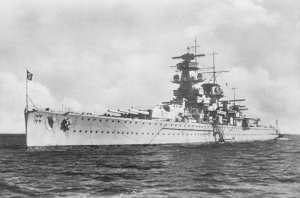
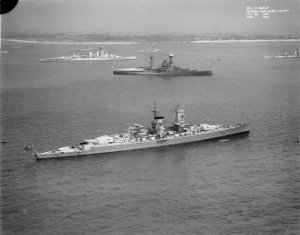
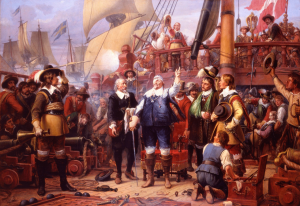
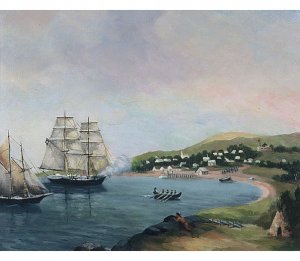



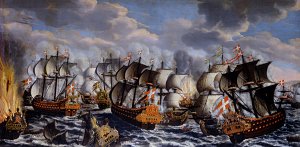
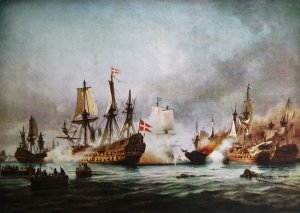
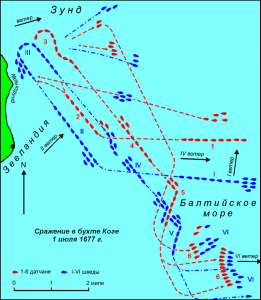
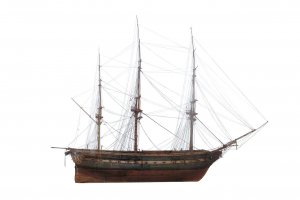
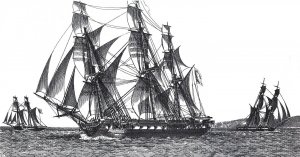
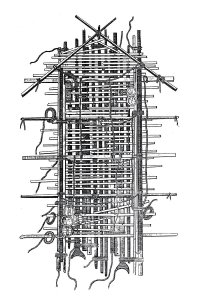
 of the tragedy stirred considerable public emotion, making Méduse one of the most infamous shipwrecks of the Age of Sail. Two survivors, a surgeon and an officer, wrote a widely read book about the incident, and the episode was immortalised when Théodore Géricault painted The Raft of the Medusa, which became an iconic artwork of French Romanticism.
of the tragedy stirred considerable public emotion, making Méduse one of the most infamous shipwrecks of the Age of Sail. Two survivors, a surgeon and an officer, wrote a widely read book about the incident, and the episode was immortalised when Théodore Géricault painted The Raft of the Medusa, which became an iconic artwork of French Romanticism.